The Potential of USB Power Delivery Receptacles

In the modern age, technology and society are connected, with the average person owning at least two devices. As technology advances, it becomes harder to manage the charging process. Hundreds of products are out there, and companies are starting to exclude charging bricks to force consumers to buy more tech. The solution comes in the form of a USB-C in-wall outlet.
USB-C devices are slowly seizing the market due to their simplistic design and powerful charging capabilities. You may notice them in newer phones, computers, or even the Nintendo Switch. The EU recently mandated that all phones be USB-C compatible by 2024, with laptops/computers outfitted by 2026. Versatility is second to speed when it comes to charging these devices.
A standard USB-C port can be thought of as a modern USB-A. But now we have Power Delivery (PD), which makes the USB-C port extra powerful. USB PD chargers can handle higher power than conventional chargers, allowing a range of compatible USB-C devices to charge extremely fast comparatively. With this in mind, Enerlites is proud to announce a new line of USB PD receptacles.
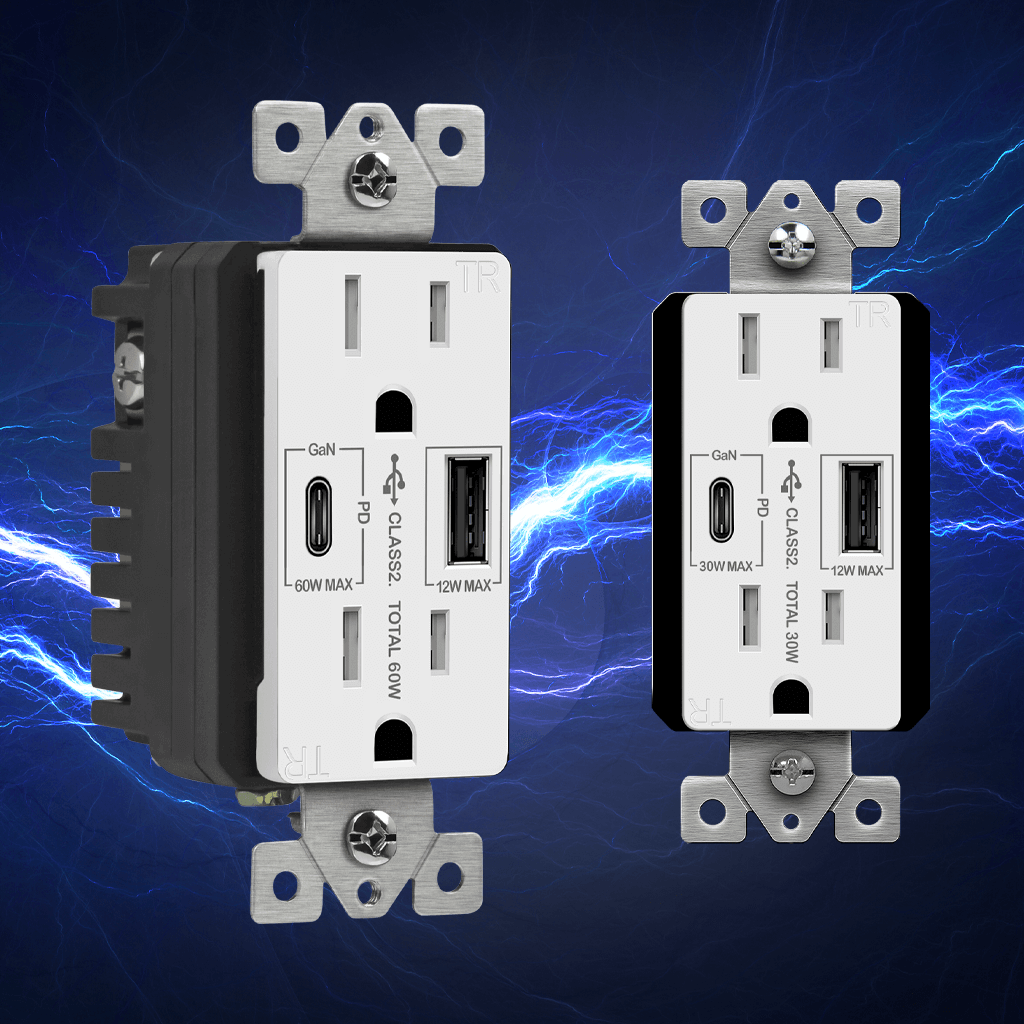
Power Delivery is a fascinating concept made more powerful through Gallium Nitride (GaN). Power Delivery chargers and receptacles are nothing new, but we strive to make innovative changes to the current market with GaN. We guarantee our new GaN products will provide fast, reliable charging for many devices. Before we jump into the products, let’s look at the development of the Gallium Nitride semiconductors that help them work.
THE HISTORY AND DEVELOPMENT OF GALLIUM NITRIDE
To understand the development of our new line of Power Delivery devices, we first need to know the history of Gallium Nitride. It’s been exactly 30 years since University of California Santa Barbara professors started working to make a viable GaN semiconductor. The issue with GaN at the time was its large amount of defects compared to silicon. Silicon crystals had around 100, while GaN had 10 billion. Silicon was the market standard, but many expected it to reach its limits soon enough. This belief occurred because silicon has a physical holding limit on transistors. Current transistors are 2 nanometers (nm) wide, while silicon’s atomic size is 0.2 nm. That means only ten transistors can fit on a silicon atom, though many expect integrity issues before that occurs. As we continue to miniaturize chips, silicon will begin to fail in its ability to keep up with both manufacturing cost and structural integrity.
In Japan, a researcher named Shuji Nakamura used a GaN-indium compound to invent the blue LED, leading to the white LED and revolutionary lighting industry changes. Nakamura joined the UCSB team in 2000 to continue revolutionizing the semiconductor field. Many of the center’s successes resulted from identifying other materials to combine with GaN to create the most-effective semiconductors and understanding/addressing GaN’s quirks. Since then, GaN has become a significant part of electronic development. It’s the basis for Blu-Ray lasers, modern LED lights/TVs, and high-quality radar systems.
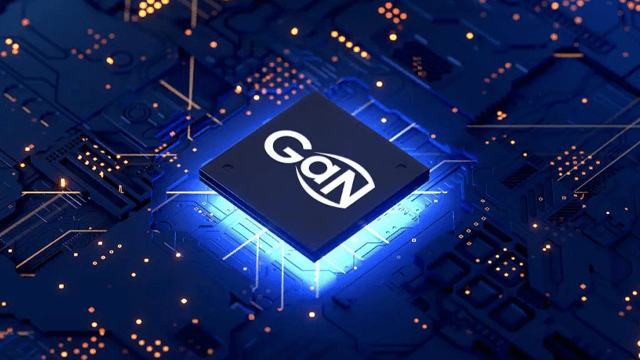
Gallium nitride has grown in importance because it offers significantly improved performance with smaller energy and space needs over conventional silicon technologies. It allows for more space as a semiconductor and is a better, more heat-resistant alternative. Estimates say that worldwide Si-to-GaN data center upgrades would reduce energy loss by 30-40%, saving over 100 TWhr and 125 Mtons of CO2 emissions by 2030. Switching to GaN chips could save 80% in manufacturing and energy costs over the next 30 years.
FEATURES & BENEFITS OF USB PD CHARGING DEVICES
It may surprise you that USB PD has been around since 2010. The driving factor behind the recent popularity of Power Delivery chargers is the ability to provide varying charge levels while acting as a universal charging specification. Most chargers have a maximum voltage of 5, with a maximum wattage of 15. PD voltage can reach up to 48V, offering 240W total. This upper limit lets them charge many types of devices, even heavy-duty laptops, with ease.
Another impressive aspect of USB PD is that it allows power to flow both ways, with no set direction based on the circuit or connection. In other words, connecting two PD-enabled devices with a USB-C cord lets one charge the other. This feature can be convenient if you don’t have access to an outlet.
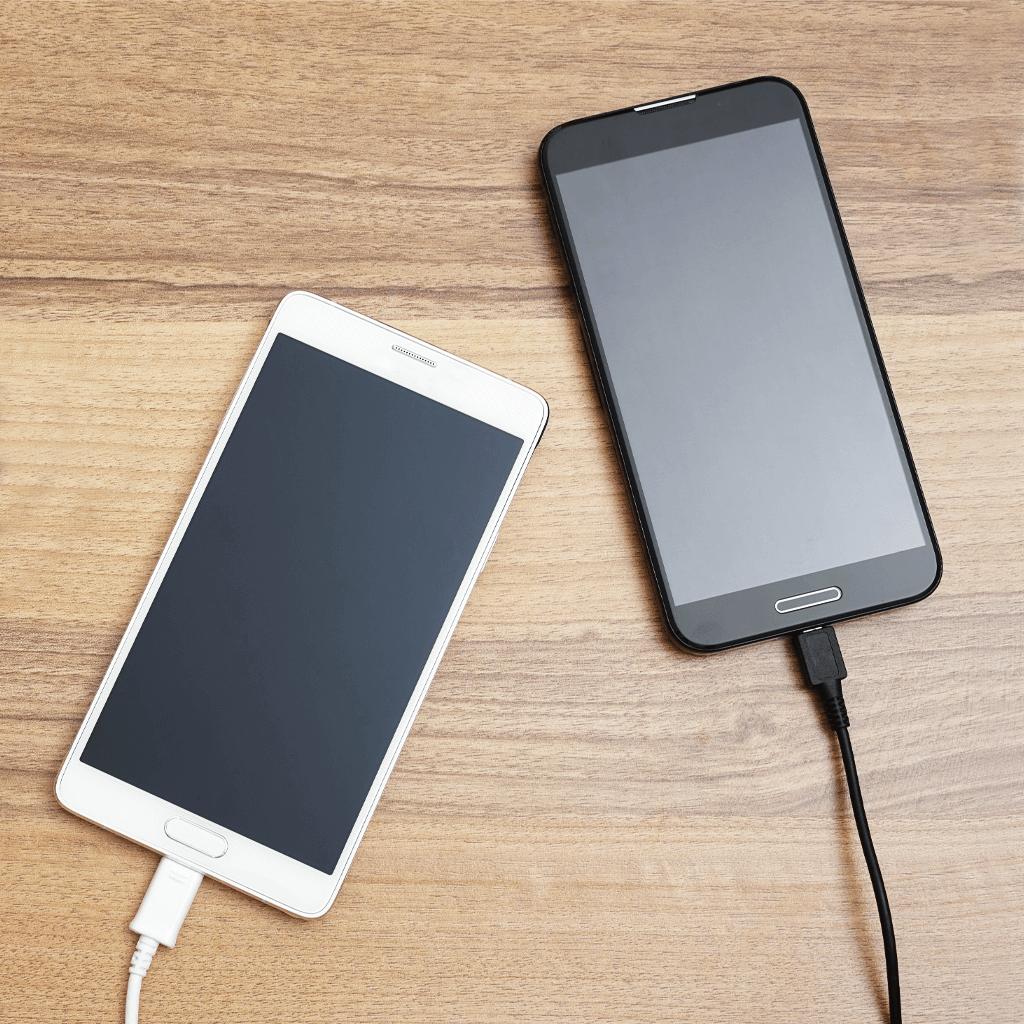
A simple but notable feature of USB PD chargers is their ability to offer faster charging and smaller size over standard devices. Using GaN chips, current USB PD fast chargers can be up to 40% smaller and charge 2.5x faster than traditional silicon-based chargers. That equates to less E-waste from bulky cords and plugs in the long run.
Lastly, USB PD chargers can communicate with the connected device. By doing so, they understand its charging needs and can match the optimal power output. Our line of USB PD receptacles employs this feature to ensure your device gets the best charge possible.
ENERLITES PRODUCTS TECHNICAL BREAKDOWN
Here is a technical breakdown of Enerlites’ USB PD receptacles to better understand their nature:
61501-1A1C-PD30
- One Type-A port and one Type-C port
- A total output of 30W
- If both ports are in use, the Type-C port has a maximum of 27W and is not PD-capable
- If only the Type-C port is in use, it will receive the full 30W load
- Best for phones and other small devices
61501-1A1C-PD60
- One Type-A port and one Type-C port
- A total output of 60W
- Type-C port receives a dedicated 60W charge no matter the amount of ports used
- Includes Programmable Power Supply (PPS) standard that allows for additional output detection and dynamic charging
- Best for dedicated, high-power charging
61501-2C-PD60
- Dual Type-C ports
- A total output of 60W
- If both ports are in use, each port will receive an even split of 30W
- If only one port is in use, it will receive a dedicated 60W charge
- Includes Programmable Power Supply (PPS) standard that allows for additional output detection and dynamic charging
- Best for quick or split multi-port charging
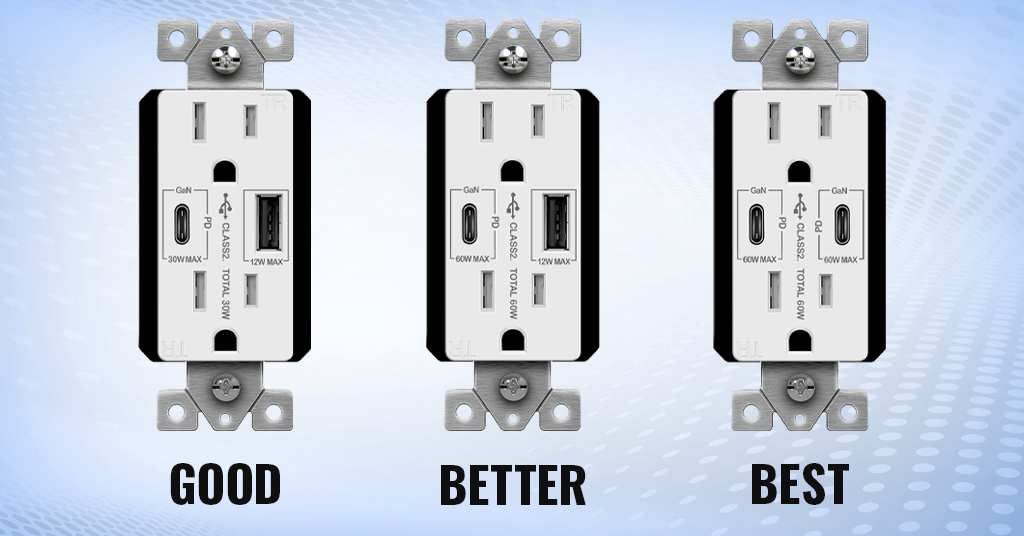
REASONS TO PICK ENERLITES USB PD RECEPTACLES
Enerlites is ahead of the curve on USB PD receptacles. Most competitors are generally more expensive, slower, less powerful, or less versatile. Though PD30 devices are commonplace, there are only two competitors for our PD60 devices: Leviton and Amerisense. Leviton’s device features pre-wired leads, which use more space in the wall box than our grounding terminals. Though the Amerisense receptacle is cheaper, it also has less versatile charging capabilities.
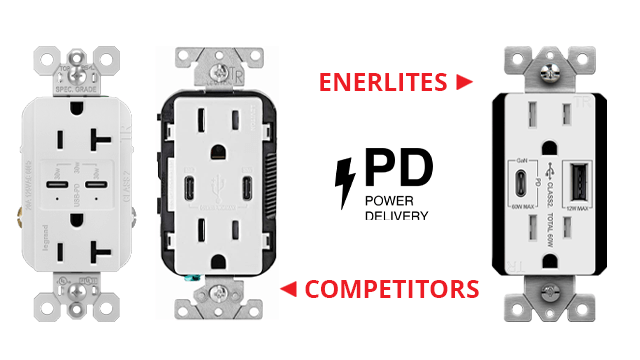
There are many reasons to pick Enerlites USB PD receptacles over its competitors. Specific devices–such as MacBooks or iPads–have limited power adapter bricks, and USB PD receptacles can bring out their full potential. Additionally, our receptacles can charge compatible devices from 0-50% in approximately 20 minutes, which is perfect for someone on the go.
With USB-C and USB PD devices on the rise, it’s essential to stay informed on the best products on the market. At Enerlites, innovation is always key, and we are proud of the devices we’ve created. For more information on our new line of USB PD receptacles, visit our store or talk to a sales representative.

